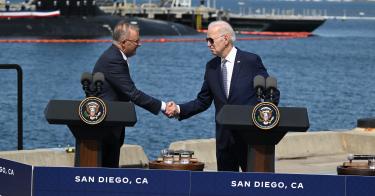On Monday, national leaders from Australia, the United Kingdom, and the United States came together in Point Loma Naval Base, San Diego, and announced a decades-long plan—AUKUS—for delivering a nuclear attack submarine capability to Australia. The intent is to tilt the strategic balance in Asia away from China, but if this endeavor is to survive looming budgetary and political tensions, some quick wins are needed.
In Australia, some see this effort as too expensive and useless, but polling indicates strong support. Meanwhile, some U.S. congressmen have expressed concerns that the agreement may strain an already struggling shipbuilding program. All three nations want jobs and economic benefits; while speaking in San Diego, Australia’s Prime Minister asserted AUKUS will generate 20,000 jobs. The plan as described seems to address these concerns well enough.
Beginning immediately, there will be increasing visits to Australia by U.S. and U.K. nuclear submarines. Australian shipyard workers and sailors, meanwhile, will arrive in the U.S. and their sailors join crews on U.S. submarines, thereby becoming acquainted with the rigors of naval nuclear propulsion. Seemingly underscoring this effort, President Biden announced that U.S. nuclear submarine Asheville is currently in Australia.
The goal is to increase familiarity with naval nuclear propulsion operations, shipbuilding, and maintenance. This will set the stage for an older U.S. Virginia-class submarine to be delivered to Australia early next decade.
These movements also provide an early and visible demonstration of America’s commitment to AUKUS. v for nuclear maintenance.
Missing from the announcement, unfortunately, was a plan to move one of the Navy’s Guam-based U.S. submarine tenders to Australia. These ships, which conduct nuclear maintenance on deployed submarines, have an obvious role in AUKUS.
By 2027 the plan is for a persistent U.S. submarine presence in Sterling, home to Australia’s submarine fleet. These boats will be supported by Australian shipyards and serve as training platforms, giving Australian nuclear submariners valuable experience. This phase of AUKUS will culminate with the delivery of a nuclear submarine—presumably one of the subs based in Australia—the first of three such sales by the early 2030s.
The final phase of AUKUS would see the co-development of a new submarine, initially built in the U.K. with later subs built in Australia. While this would not occur until the 2040s, it nevertheless appears to add undue complexity to a nascent Australian program that would eventually be required to sustain multiple classes of submarines.
The plan, however, does a good job of balancing trilateral domestic interests, while taking a methodical approach to building Australian naval nuclear propulsion competencies. Building a naval nuclear enterprise with its culture of exacting standards takes time, but is critical to the safe operation of an effective nuclear-powered undersea force.
In any scenario, AUKUS will be a very expensive and decades-long endeavor. The complexity and length of the plan highlights some obvious deficiencies in the latest announcement.
>>> China on the Mind: It Will Be a Busy Year for Australia
Absent are details on Australia’s financial commitment, which should complement efforts to grow U.S. submarine shipbuilding capacities. Also missing are any details regarding Australia’s proposed support to visiting U.S. nuclear platforms and staff. Lastly, the late addition to AUKUS of a second advanced technology effort, focusing on collaboration on emerging technologies like artificial intelligence and quantum computing, risks diluting political and budgetary commitments critical to a successful nuclear submarine program for Australia.
To survive over the long haul, AUKUS will need to deliver visible results in the next couple years. Those quick wins should include expanded U.S. submarine shipbuilding capacity and a more sustained U.S. forward presence in the Indo-Pacific. Most impactful in the near-term would be the movement of a U.S. submarine tender to Australia, arrival in the U.S. of significant numbers of Australian shipyard workers to learn how and assist in building submarines, and the hosting of a U.S. rotational submarine presence in Australia.
Three national leaders have spoken. That’s all well and good, but that’s the easy part. Delivering on AUKUS promises will require their personal commitment and that of their successors for years to ensure that it succeeds.
This piece originally appeared in 19fortyfive




